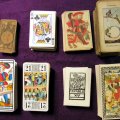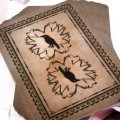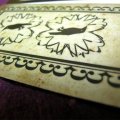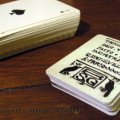About the deck
TRIOMPHES DE PARIS
22 Tarot cards
General informations about Tarot

Tarot is a game made of 78 cards, divided into five suits, following a rule dating back to (at least) 1650 :
« Ce jeu qui est composé de soixante & dix-huict Cartes, se peut distribuer en cinq bandes, la première & la plus noble de toutes appellée triomphes qui sont au nombre de vingt-deux : & les quatre autres couleurs ont nommées d'espées, bastons, couppes & deniers, chacune desquelles a quatorze cartes : Sçavoir le Roy la Royne, le Chevalier, & le Faon qui s'appellent aussi les quatre honneurs & le reste depuis le dix jusques à l'az. [... ] »
« That game, made of 78 cards, can be distributed into five suits, the first and noblest one if them is called Triumphs/trumps, going by the number of 22, and the 4 other colours are called Epees(swords), Batons(staffs), Coupes (cups) and Deniers(coin, penig), each of which has 14 cards : King, Queen, Knight and Knave, also known as the four honors, and the rest from ten to ace [... ] »
The 56 remaining cards form four suits which follow the usual latin suits, with a peculiar structure composed of 10 numeral cards and four court cards. The fifth suit has no suit symbol, it is composed of 22 pictures or allegories, of which only 21 are numbered in the French tarots.
Nowadays, French players call this suit the Atouts (at all), from the italian "a tutti", for those cards win over any suit card. Beginning with Paul Christian, occulists called the trumps Major Arcanas (or Lame Majeures) [from Thierry Depaulis introduction to the anonymous french tarot ] - the other cards becoming the "minor arcanas". Following this usage, "Triomphes de Paris" would be a "major only" deck.
The famous "tarots" who give the game its name were only seven. Three of them are part of the trump suit : the unumbered ont, known as Mat, Fol, Fou (the fool), the number I, le Bateleur (the mountebank), and the twenty-first, Le Monde (the World) which won over any card save for the untouchable Mat. The four other tarots were the king in each of the four suits.
Triomphes de Paris
The tarot from Jacques Vieville - master cardmaker in Paris up to 1643 - was a guide or a model in order to create these cards.
Synthetic, the manufacturing volontary gave up on the 56 suits cards and colouring, focusing on the lines and the trumps.
The name was pretty obvious, being a suit of trumps (Triomphes) and made in Paris, inspired by a Parisian cardmaker.
To stay as close as possible to the spirit of ancient card engravers, it was necessary to cut relief blocks, following the imposed traditional trame regarding the orders and allegories, still creating an original design..
Almost each step of traditional ancient cards (save for the colouring) enable to taste the steps the apprentice had to follow to become an accomplished craftsman or an installed "master" with a storefront, paying taxes and taking in charge the teaching of other craftsmen, which would eventually pass on the tradition until it disappeared.
Without going too deep in the analysis of Vieville Tarot deck – a work already done by Charly Alverda in his book Trois figures hiéroglyphiques – we shall note a few elements that might enable the Paul Marteau's "Ancient Tarot de Marseille" (or the genuine Nicolas Conver tarot) amateur to find his marks.
Vieville used slight difference in the more common trumps order - such as the order used by his neighbour Jean Noblet. Justice and the Chariot are permuted, VII and VIII, so are the Hermit and Strength, XI and IX - not VIIII as in other french Tarots, but IX, a numeration Vieville also uses on the card XIX (Sun).
Naming his cards in a strange poem on the Ace of Deniers and the Two of Cups, he omits or name ambiguously : Death (XIII), Judgement (ASONDETROMPE ? XX), Tempérance (CESTE.DAMEQUY ouDAMEQVV ?XIIII), the Hermit (VIELART ? XI), Wheel of Fortune (X), the Chariot (TRANNAY ? VIII). The fool and the Mountebank are called MA (for MAT) and BAGA (for BAGAT, probably derived from the italian form of Bateleur). The XVIth card, usually "MAISON DIEU" (the tower) is replaced by LA FOVDRE (thunder), an allegory found in other tarot decks. Almost all S are reversed. The Sun shines over a young rider, bearing an oriflam orned with a cross ; the Moon light a lady spinning wool (?) ; what looks like an astrologue observes the stars with a divider or compass in a monumental setting. The mult faced devil is alone smoking and running from right to left ; the mysterious Dame holds in her right hand a recipient, pouring its content in another one on the ground, while her left hand holds a winged cadeceus like scepter, on her right an S shaped banner is floating, with the sentence "SOL FAMA" in which each letter is reverted (making the S in a regular orientation compared to the other letters). The "Hermit" (VIELART which could be translated to old man) has no lamp nor hourglass. The hanged man is numbered IIX instead of XII making us wonder where are the top and bottom. Strength has a curious leg naked from the foot to the knee.. Chariot is pulled by two sphinxes. Those who would like to dig deeper in those peculiar details should read Charly Alverda's book cited earlier.
CHOICES MADE
Making only the trumps suit : to synthetize the game spirit, this suit being the principal distinction of a Tarot deck towards other playing cards decks.
Smaller size : not an unprecedented choice - see Jean Noblet's deck - but here using only a fraction of the surface, which is an advantage regarding certain technical details. Without a proper cardmaker workshop, the cards size is scaled to the productions means.
No colours : whoch colours chose ? Old recipes may be hard to recreate, the time to do the colouring and the drying would have been much too long. Plus, any added step may compromise other steps, colouring can ruin the smoothing or vice-versa. Moreover, in ancient cards, colour seem to enhance the lines, putting certain elements in relief, never making the essence of the "message" (even if the colours may be at times completely necessary). Using only one colour might have been an option, but then which one ? It sounded more pragmatic to avoid colouring.
I decided to put the names on the cards. Vieville omitted certain cards or used certain sentence that would not fit on the deck. For those choices, the « trois figures hiéroglyphiques » cited earlier were of a great help.
DAME XIIII and VIELART XI were pretty obvious, noted and confirmed by C.A.
CHARIOT VIII was using a clear allegory, so the name doesn't betray the master cardmaker. Same for ROVE DE FORTVNE X, although the name was a bit long for the smaller size.
XIII is kept unnamed as it is done in many marseille pattern tarot decks.
Last, YVGEMENT XX was construted from YUSTICE, since « SON DE TROMPE » or « TROMPE » would be a weird double entendre in french – although cartomancers might find interesting to meditate on calling the judement "TROMPE", which means in french trumpet, but also wrong, and overall "betray" or "lie" as in trompe-l'œil.
It shall be noted that LUNE XVIII is the only word using a modern U : this deck is no restauration nor fake, this modern writing intend to be a time signature - which shall be noted as the reversed N invite to do - also a clin-d'œil to my friend Charly.



